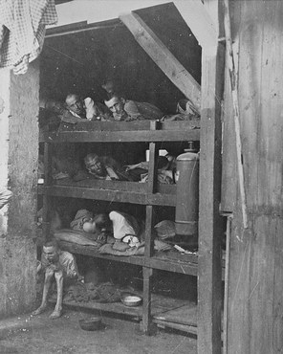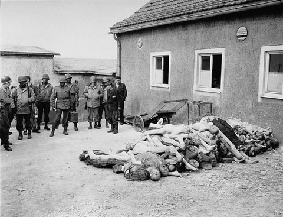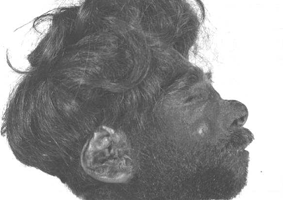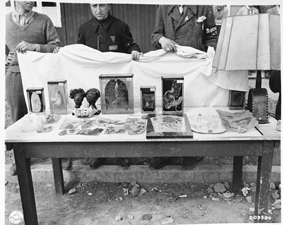
Liberation of Buchenwald...
Weimar is a famous German town known for centuries for its cultural life. Goethe, Schiller, Franz Liszt, and Bach lived in Weimar. Goethe used to climb the Ettersberg and sit and work under a beech tree. It was this place which was chosen by the Nazis to establish the concentration camp of Buchenwald (Beech Wood)

Liberation of Buchenwald...
On June 3, 1936, the Inspector of Concentration Camps, SS General Eicke, proposed to transfer the concentration camp of Lichtenburg to Thuringia. The field of Ettersberg was officially chosen on May 5, 1937 and on July 16, 1937, the first 300 prisoners arrived in the camp (at this time, the name of the camp was "Konzentrationslager Ettersberg"). On August 6, 1937, the name of the camp was changed to Konzentrationslager Buchenwald (Buchenwald Concentration Camp).
Like in many other concentration camps, the population of Buchenwald increased dramatically: in July 1937, there were 1,000 inmates in the camp. The population increased to 5,382 on September 1, 1939 and to 8,634 inmates by the end of September 1939 (because of the invasion of Poland). By December 1943, the population of the camp had reached 37,319. There were 63,084 prisoners in Buchenwald in December 1944, and the population reached 80,436 in late March 1945.

Liberation of Buchenwald...
The camp was built by the prisoners. During the entire summer of 1937, the SS forced the prisoners to use their "free time" to carry huge stones from the quarry to the camp. Those who had the misfortune to carry stones that were too small in the eyes of the SS, were immediately killed. Later, dozen of prisoners were chained to huge four-wheel carts and had to pull enormous loads to the camp while forced to sing by the SS. The SS used to call those prisoners the "Singing Horses".
The first commandant of Buchenwald, SS officer Koch. Koch and his wife, Ilse Koch, were famous for their murderous qualities. Koch was a thief, a drunkard and a gambler. In 1941, he was transferred to Majdanek and replaced by SS Colonel Pister. Later, Koch was accused of fraud and thief, arrested by the SS, and executed in Auschwitz.
The official goal of Buchenwald was the destruction of the prisoners by work. Thousands of prisoners were murdered in Buchenwald by work, torture, beatings, or simply starvation and lack of hygiene. One of the worst criminals of Buchenwald was certainly Martin Sommer, who "worked" in the bunker - the high security prison of the camp.
Thousands of inmates, especially Soviet POWs, were murdered in the infirmary by lethal injections, whereas others were the victim of medical experiments, especially many who were contaminated by the typhus bacillus.

A "souvenir" made by the SS: the shrunken head of a Russian POW...
Another way to kill prisoners was used in the stable. The prisoners had to enter a fake infirmary room and place themselves under a height gauge. At this time, an SS man killed them with a revolver by shooting through a small hole placed at the height of the prisoners neck. The noise of those executions was masked by a radio at maximum volume.
There were many ways to exterminate prisoners by work in Buchenwald. Thousands of prisoners died during the construction of the road leading from the foot of the Ettersberg to the entry of the camp. This road was called "Blood Street " by the prisoners.
Despite the abominable living conditions and the SS terror, a powerful underground organization was created in the last years of the activity of the camp. Numerous prisoners sentenced to death by the SS were hidden in the camp. This was made possible by the overcrowding of Buchenwald.
Extract from the Nuremberg Trial.
Mr. Dubost (French prosecutor): Could you please tell us about the tattooed skin?
Witness Bachalowsky: Yes.
Mr. Dubost: Please tell us what you know.
Witness Bachalowsky: In Buchenwald, human tattooed skin was placed in Block 2. This block was called the "pathological block".
Mr. Dubost: Could you tell us if there was much tattooed skin in this block?
Witness Bachalowsky: There was always human skin there. I can't tell you exactly how much there was because there was a lot of traffic in this block. There was not only tattooed skin but also tanned human skin without tattoos.
Mr. Dubost: Does this mean that they skinned prisoners?
Witness Bachalowsky: They skinned prisoners, then they tanned the skin.
Mr. Dubost: Could you give us more details about that?
Witness Bachalowsky: I saw the SS leaving Block 2 with human skin in their arms. Some comrades who worked in this block told me the SS received orders for human skin, and that tanned skin were given to the guards and visitors. Human skin was also used to make book covers.
Mr. Dubost: We have been told here that the former commandant, Koch, was punished for that.
Witness Bachalowsky: I don't know about that case, I was not in the camp at this time.
Mr. Dubost: So, were there human tattooed and tanned skin in the camp after Koch left?
Witness Bachalowsky: There was always skin. When the Americans liberated the camp, they still found tattooed and tanned skin...

Found in the pathology block of Buchenwald: tattooed and tanned skin, two shrunken heads of russian POWs, a lampshade made of human skin...
Testimony of Ludwig Scheinbrunn,
survivor of Buchenwald
"As of September 21, 1939, I was obliged to carry corpses in Buchenwald. I did that for 2 and a half years. During the winter of 1939, they erected a tent camp near the actual crematorium, where more than 40 prisoners died every day, from cold and starvation. As well, the SS adjutants Blank and Hinkelmann poisoned many of them. The prisoners received a half-liter of light soup and one bread for 8 inmates. It happened once that two prisoners were carrying the corpse of one of their comrades, hoping to receive a bigger bread ration. Blank and Hinkelmann often threw the food in the mud, so the prisoners had to kneel to get it while Blank and Hinkelmann beat them with sticks and whips. . . ."